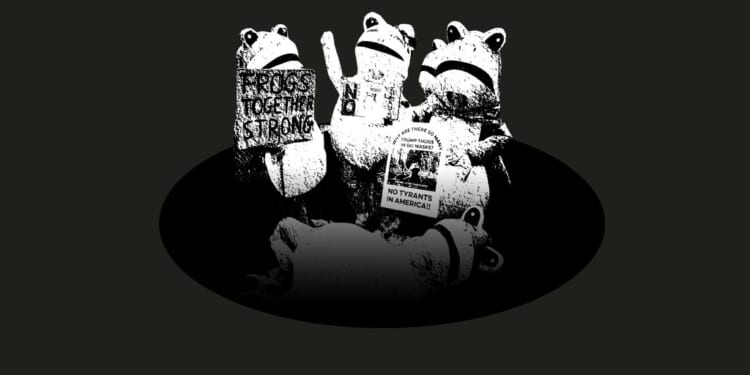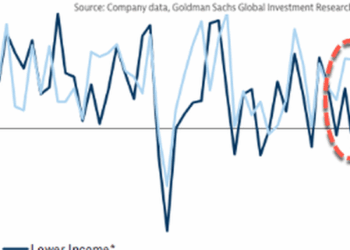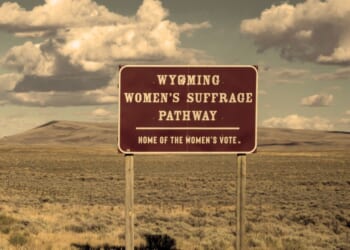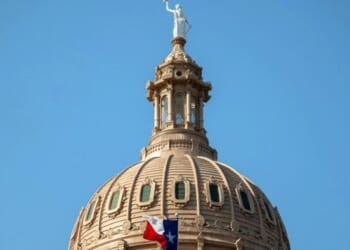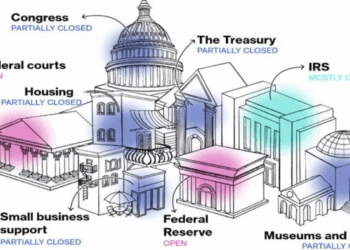
The uses of cringe.
The most distinctive feature of “No Kings” was the outlandish inflatable outfits worn by some protesters. You’d be forgiven for assuming that was a case of college kids getting baked and using the occasion to parade around in kitschy attire as a goof, but it wasn’t. It was a deliberate tactical choice borrowed from other anti-Trump demonstrations.
Ground zero for cringey costumery is the ICE facility in Portland, Oregon, a target of regular “low-energy” protests for the last few months and recently the focus of Trump’s latest National Guard deployment. After the president dubbed the city war-ravaged to justify sending in the troops, demonstrators there mocked him for his hysteria by making their assemblies as comically unthreatening as possible. People began showing up dressed as cartoon animals; on one occasion, nude bicyclists pedaled by the building en masse.
The mockery caught on. A new organization has now been formed to collect donated inflatable costumes and distribute them to demonstrators at other ICE sites. “We want to make it clear that this is not a war zone,” one of the founders told a Portland TV affiliate, “and that if [Trump] wants to invoke the Insurrection Act, he’s going to have to point at people in inflatable chickens and inflatable frogs and inflatable unicorns.”
That’s clever, and it was clever for “No Kings” participants to take advantage of the national media spotlight to mainstream the tactic. Republican goblins in Congress stooped lower than usual last week in demagoging the rallies beforehand as a “hate America” protest organized by the “terrorist wing” of the Democratic base that would supposedly lead to riots. Imagine the average American, having absorbed all of that and expecting something akin to a Hamas rally, turning on the Saturday news to see human unicorns in red-white-and-blue top hats flouncing about.
Through sheer absurdity, the protesters are denying the president the bespoke reality he hopes to create in order to rationalize a military crackdown on demonstrations. They’re making their rallies so laughably innocuous that even fascists will struggle to convince the public that state violence against them is necessary. As one Democratic strategist put it to the Washington Post, “The silliness is the point.”
Silliness is also contagious, which is useful if you’re keen to keep the troublemakers in your own ranks in line. “When you have the inflatables, everyone starts dancing,” an activist told the Post, “and even the people who are very serious, they continue what they’re doing, they’re disciplined … but they’re not angry. There’s not an angry vibe behind them.” It felt like a victory for the organizers when Sen. Mike Lee, a zealous Trump apologist, resorted to making fun of the protesters’ dance moves because he lacked any useful “Antifa is coming to kill you” footage from the day to exploit.
Disarming the government and disarming their own side’s violent chuds: Absurdism has served the “No Kings” folks pretty well. The civil rights movement of the 1960s accomplished that same sort of dual disarmament by insisting on nonviolence, knowing that doing so would alienate allies they didn’t want or need and lead average Americans to sympathize with them when the state brutalized them gratuitously. “I Am a Man,” their signs famously read. Sixty years later, in a dumber and more decadent country, “I Am a Unicorn” gets the job done.
And so, unusually for a protest in America, “No Kings” accomplished something meaningful. It correctly anticipated the next stage in Trump’s authoritarian takeover and seized an opportunity to try to debunk the pretext for it. The president’s critics aren’t threatening anyone, they aimed to show, so there’s no reason for him to threaten them with military action in return. The rallies may have meaningfully moved the needle of public opinion against future troop deployments by damaging Trump’s credibility when he screeches about civil unrest. In a post-persuasion society, that’s no mean feat.
They may have accomplished something else too. “The ‘No Kings’ protests had one specific and concrete aim: breaking the mirage of Donald Trump’s supposed mass popular mandate,” our friend Andrew Egger explained today at The Bulwark. Trump has a mandate was a distressingly stupid yet popular MAGA retort to the protests on social media this weekend, as if a guy who’s underwater on every major issue somehow gained a divine right to rule without legal constraint from the not-quite-majority of the popular vote he won last fall.
The reaction was putrid enough that our own Jonah Goldberg felt obliged to remind his right-wing followers on Twitter that there’s nothing in our law, history, or tradition that says a president with a “mandate” gets to do any ol’ thing he wants. The whole point of having a written Constitution is that he doesn’t: His powers, like the legislature’s and the judiciary’s, are circumscribed—or they’re supposed to be. If you resent other Americans for caring about that, our system of government isn’t for you. What you want is … a king.
If it’s any consolation, you might have one before too much longer.
Dark linings in a silver cloud.
As clever as the “silly strategy” for the protests was, it reflected how high the authoritarian tide has already risen.
We must be as goofy and innocuous as children or else the military might attack us and the Justice Department might arrest our donors isn’t a glorious endorsement of the American experiment. You should be righteously furious at what Trump and the GOP have done to our country and what they’re planning to do; if you’re hiding that fury in a cartoon chicken costume, it’s because the United States is already sufficiently unsafe for critics that you feel obliged to make a joke of your dismay in order to deny the government a reason to persecute you.
You’re welcome to protest—as long as you smile. But be careful not to scowl.
Sixty years ago, civil rights marchers didn’t need costumes to telegraph their nonviolent intentions. They trusted that Americans would judge them by their actions. In 2025, that seems preposterous: To overcome the bad-faith narrative spun by right-wing propagandists that all dissenters against the great nationalist project are terrorists, nothing short of dressing like My Little Pony will do.
And even that won’t work in the end. Not a single person reading this believes the president won’t invoke the Insurrection Act at some point, despite the best efforts of the demonstrators to deny him an excuse.
There’s something strange, frankly, about staging a protest to influence public opinion in a nascent autocracy. Autocrats don’t care about public opinion; that’s what makes them autocrats. Trump won’t care if Americans disapprove of him invoking the Insurrection Act any more than he’s cared when they’ve disapproved of his other military deployments. Mass popular uprisings are the only form of resistance that autocrats worry about, and there’s no evidence that the modern United States is capable of such a thing, notwithstanding Saturday’s impressive showing.
Even if it were, suppressing mass popular uprisings is what the Insurrection Act is for, no?
I wonder too whether “No Kings” ended up putting off some Trump critics. The silliness succeeded in undermining his demagoguery about terrorism but it also seemed, well, silly. For months leftists have savaged congressional Democrats for forever warning of an urgent authoritarian threat to democracy yet never acting like it by fiercely resisting the president’s tactics. (The current shutdown was partly designed to answer those complaints.) “No Kings” had a touch of the same problem: How dire can the fascist incursion really be if the solution involves pretending to be a giant Labubu?
Are low-engagement voters upset about inflation more likely to be drawn into the streets by a movement like that, or by a movement that acts like it’s angry and afraid of what the president is plotting?
The apparent age skew among the protesters on Saturday is another potential problem. There’s no way to know how old the average demonstrator was, but it seemed to many observers that gray hair was overrepresented in the crowds. “That’s because younger people were working,” you might say. Okay—but it was a Saturday, and younger people managed to turn out for mass protests years ago despite the fact that they were also more likely than senior citizens to be working. If it’s true that “No Kings” is mostly interesting to older adults, that bodes ill for the future of the so-called Resistance.
And there are reasons to think it might be more interesting to grandmas and grandpas. One is civic: The more vividly you remember America in the Before Times, the more exception you might logically take to what it’s become in the After Times. Young adults don’t have the same classical liberal expectations from politics that their elders did, as we’re now regularly reminded. Tadpoles boil faster than frogs do.
The other reason is technological. When “No Kings” held their last rallies in June, Dispatch contributor Charles Fain Lehman made an astute point about how anachronistic the demonstrations felt. “I think what’s interesting is like the idea that we should have 50 state protests, which is the biggest protest ever, is like such a boomer thing to do,” he said. “It’s just like what we, how should we oppose Donald Trump? Well, we’ll go out and we’ll sing about how there should be no kings and we’ll march out. Like, Zoomers don’t do that. That’s not how they think about political engagement at all. They’re on TikTok all day.”
As if to illustrate the point, our boomer president responded to the protests on Saturday by posting 19 seconds of AI slop online that imagined him as a fighter pilot dropping—I kid you not—feces on the demonstrators. Say what you will about him, the president understands his country.
Mass protests, like opinion punditry, are an antiquated form of political activism that appeal mostly to older people. In an America that’s increasingly atomized, housebound, and unable to look away from screens, how much does anyone under the age of 50 care about demonstrations?
An illusion of normalcy.
Maybe the antiquation is the point, though.
If the core virtue of the protests is their therapeutic value, it makes sense that the organizers would agitate in a style reminiscent of the 1960s, not the 2020s. The great fear of all Trump critics is that America is no longer America; what better way to reassure yourself that it is than by resurrecting protest tactics from the history books?
The civil rights movement won. The Vietnam-era antiwar movement also won, sort of, by creating political momentum for Americans to turn against the war. Showing up by the millions on Saturday was a blind wager of sorts placed by “No Kings” participants that what worked before will work again. Past is prologue. Resistance to oppression will prevail. America is still America.
We’ll see. As I said last week, “America is still America” is a narrative that inadvertently helps Trump by making his attempt to consolidate power seem less unprecedented than it is. How alarmed can we really be by him siccing the IRS on his political enemies and declaring war unilaterally on Venezuela and commandeering the appropriations power from Congress if 80-year-olds remain free to dust off their old M-65s and march against him?
How can this be fascism, even after he invokes the Insurrection Act, if chattering monkeys like me still get to rip on him in print every day for the enjoyment of the small sliver of the public that hasn’t already filtered viewpoints like mine out of their bespoke reality?
In the end, the most lasting achievement of “No Kings” will be that it was a morale booster for a faction that’s horribly demoralized, and a respectable show of force toward a reptilian-brained leader who understands politics only in those terms. And maybe that’s enough.

